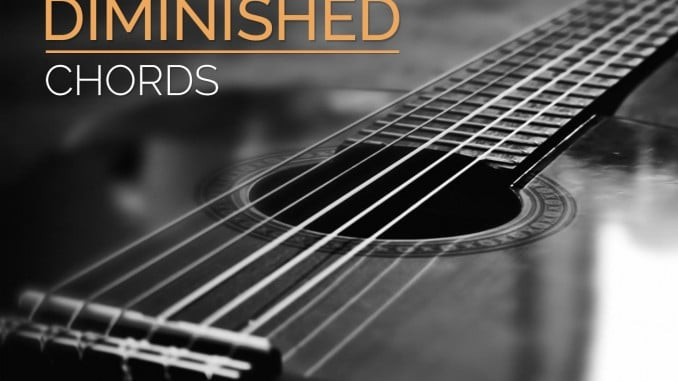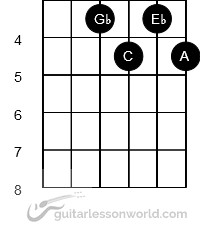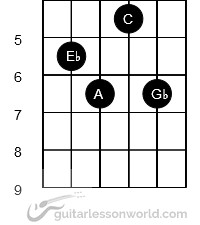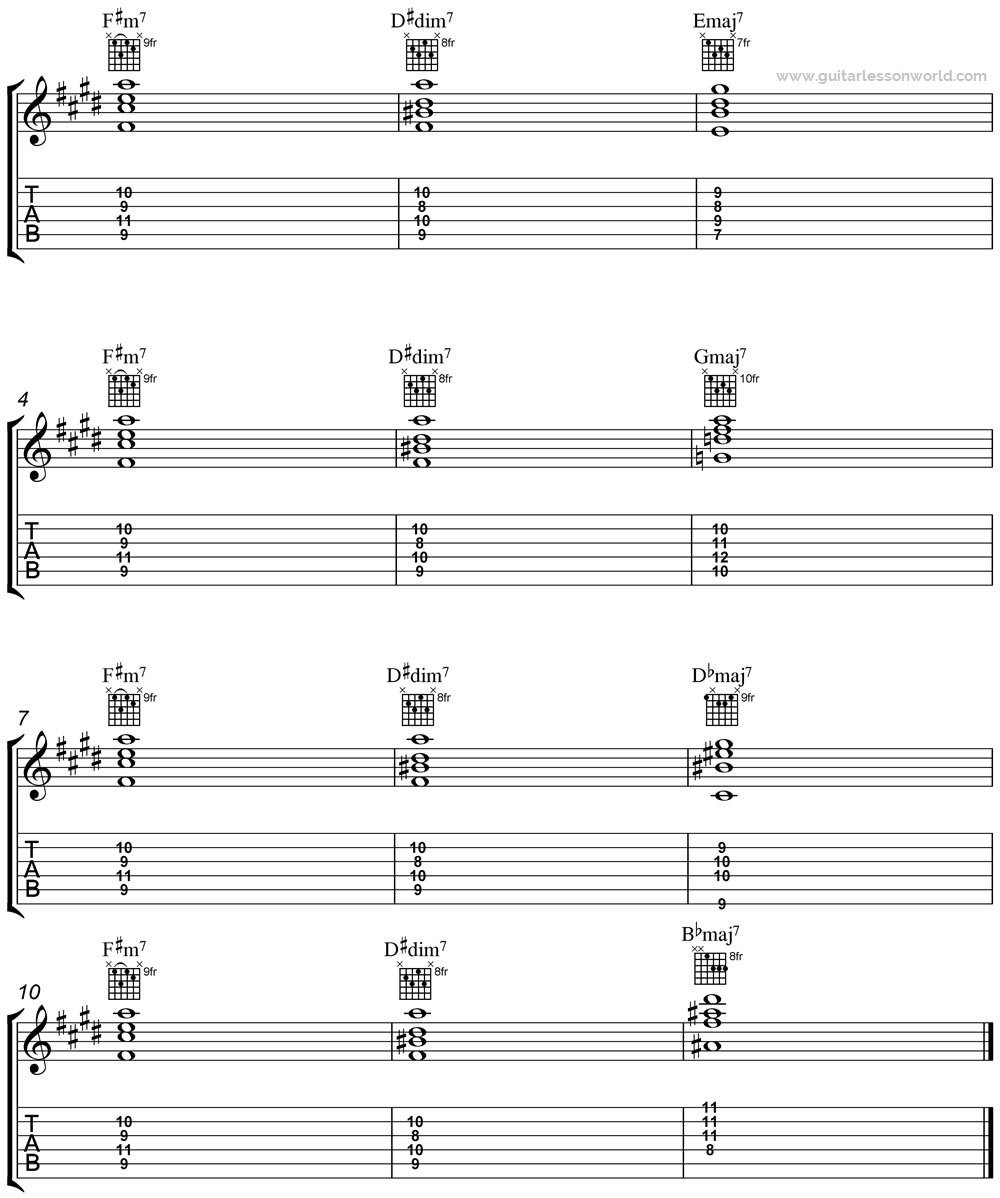Diminished chords. The very name sounds intriguing, perhaps even a little intimidating. These chords are known for their dissonant, tension-filled sound, often described as unstable or unresolved. While they might not be the first chords you reach for in your everyday strumming, understanding diminished chords opens up a world of sophisticated harmony, particularly in genres like jazz. On the guitar, mastering diminished chords unlocks unique sonic textures and creative possibilities.
 Diminished Chord Diagram Featured on GuitarLessonWorld.com
Diminished Chord Diagram Featured on GuitarLessonWorld.com
Unpacking the Diminished Chord Formula
To truly grasp diminished chords on the guitar, let’s start with their fundamental construction. In major keys, the diminished chord naturally arises from the 7th degree of the major scale. Think of the C major scale: C-D-E-F-G-A-B-C. The chord built on B, the 7th degree, is a diminished chord.
The formula for a diminished chord, derived from its parallel major scale (for example, creating a C diminished chord from the C major scale), is:
Diminished Chord Formula: 1-♭3-♭5
This formula tells us to take the root note (1), flatten the third (♭3), and flatten the fifth (♭5). For a C diminished chord (Cdim), this translates to the notes C, E♭, and G♭. On the guitar, you can play these three notes to voice a diminished chord. However, for practical playing, learning movable patterns is key, just like with any other chord type.
Exploring Diminished Chord Patterns on Guitar
There are numerous ways to grip diminished chords on the guitar neck. Below are some common and playable diminished chord patterns. Notice the recurring shapes and the subtle variations between them. As you’ll see, diminished seventh chord patterns, which we’ll explore next, often feel even more intuitive to use.
Delving into the Diminished Seventh Chord Formula
The diminished seventh chord takes the diminished chord a step further by adding another flattened note. Specifically, it adds a double-flatted 7th (♭♭7) to the basic diminished chord structure.
Diminished 7th Chord Formula: 1-♭3-♭5-♭♭7
Let’s take C diminished 7th (Cdim7) as an example. Applying the formula:
Cdim7 = C-E♭-G♭-B♭♭
Now, you might notice that a double-flatted 7th (♭♭7) is enharmonically equivalent to the 6th. In the case of B♭♭, it’s the same pitch as A. So, for practical purposes, you can also think of the diminished 7th chord formula as:
Practical Diminished 7th Chord Formula: 1-♭3-♭5-6
Using the double flat notation (♭♭7) is crucial in music theory to ensure we correctly identify the interval and maintain proper harmonic analysis.
Understanding Diminished Intervals
Diminished chords, and especially diminished 7th chords, are built upon a foundation of minor third intervals. Let’s break down the intervals within a Cdim7 chord:
- From C to E♭ is a minor third.
- From E♭ to G♭ is a minor third.
- From G♭ to B♭♭ (or A) is a minor third.
- And, completing the circle, from B♭♭ (or A) back to C is also a minor third.
This consistent stacking of minor thirds gives the diminished 7th chord its unique symmetrical property.
This symmetry means any of the four notes in a diminished 7th chord can be considered the root. This inherent ambiguity contributes to its dissonant character but also unlocks fascinating possibilities for chord voicings and movement. Because of this symmetrical structure, shifting a diminished 7th chord pattern up or down by a minor third (3 frets on the guitar) results in another diminished 7th chord voicing with the same notes, just arranged differently.
Exploring Drop-2 Diminished 7th Patterns on Guitar
Drop-2 voicings are a common and sonorous way to play chords on the guitar, and they work beautifully with diminished 7th chords. Here are a couple of useful Drop-2 diminished 7th patterns:
The Power of Diminished 7 Chord Shifting
One of the most remarkable aspects of diminished 7th chords on guitar is their shiftability. As mentioned earlier, due to their symmetrical construction with minor third intervals, you can move a diminished 7th chord shape up or down by three frets (a minor third) and create another diminished 7th chord voicing containing the exact same notes, just in a different order. This gives you four distinct voicings for every diminished 7th chord grip you learn! This is an incredibly valuable tool for guitarists.
Diminished 7th Chord Shift Example 1
 Cdim7 chord shift example 1, illustrating movement on the fretboard.
Cdim7 chord shift example 1, illustrating movement on the fretboard.
Diminished 7th Chord Shift Example 2
 Cdim7 chord shift example 2, demonstrating another fretboard movement.
Cdim7 chord shift example 2, demonstrating another fretboard movement.
How Diminished 7th Chords Function in Music
Diminished chords, especially diminished 7th chords, aren’t workhorse chords like major or minor chords. They are used more sparingly, adding color and harmonic interest. While you can use a basic diminished chord in a major key (it naturally occurs on the 7th degree), it’s not a frequent occurrence.
Diminished chord theory is a deep dive in itself, deserving its own dedicated study. However, one of the most significant applications of diminished 7th chords, particularly in jazz, is as chord substitutions.
Diminished 7th chords are powerful substitutes for Dominant 7♭9 chords (Dominant 7 flat 9). In fact, each diminished 7th chord can substitute for four different 7♭9 chords!
The Logic Behind the Substitution
Let’s examine the formula for a 7♭9 chord:
7♭9 Chord Formula: 1-3-5-♭7-♭9
Now, observe the intervals within a 7♭9 chord:
- From the 3rd to the 5th is a minor third.
- From the 5th to the ♭7 is a minor third.
- From the ♭7 to the ♭9 is a minor third.
Recognize those intervals? They are the same minor third intervals that build a diminished 7th chord! If you add a root note, often played by the bass, beneath these upper intervals, you essentially create a 7♭9 chord.
Considering the interchangeable voicings of diminished 7th chords, you can effectively find a related 7♭9 chord by locating a root note a major third below any note in the diminished 7th chord.
For example, take Cdim7 (notes: C-E♭-G♭-A).
- A♭ is a major third down from C, so Cdim7 can substitute for A♭7♭9.
- B is a major third down from E♭, so Cdim7 can substitute for B7♭9.
- D is a major third down from G♭, so Cdim7 can substitute for D7♭9.
- F is a major third down from A, so Cdim7 can substitute for F7♭9.
A simpler way to approach this substitution practically is to take the root note of the 7♭9 chord you want to substitute, raise it by a semitone (one half step), and play that diminished 7th chord.
- For A♭7♭9, use Adim7.
- For B7♭9, use Cdim7.
- For D7♭9, use E♭dim7.
- For F7♭9, use G♭dim7.
Remember, Adim7, Cdim7, E♭dim7, and G♭dim7 are all enharmonically related and use the same set of notes, making them fully interchangeable in this substitution context.
Context: When are 7♭9 Chords Used?
7♭9 chords, and consequently their diminished 7th chord substitutions, are primarily used in diminished harmonies. This is a complex area of music theory, but you can start incorporating these chords into your playing by understanding their dominant function.
Like typical dominant chords, 7♭9 chords (and their dim7 substitutes) create a strong pull to resolve, typically down a perfect fifth or up a perfect fourth. This resolution allows you to move to one of four different major chords from a single diminished 7th substitution.
- A♭7♭9 resolves to D♭maj7
- B7♭9 resolves to Emaj7
- D7♭9 resolves to Gmaj7
- F7♭9 resolves to B♭maj7
Notice the resolution pattern: each major chord is a half step (semitone) higher than one of the notes within the diminished 7th chord.
- D♭maj7 is a semitone above C (from Cdim7).
- Emaj7 is a semitone above E♭ (from Cdim7).
- Gmaj7 is a semitone above G♭ (from Cdim7).
- B♭maj7 is a semitone above A (from Cdim7).
This means you can use a diminished 7th chord to smoothly transition to various keys. Since Cdim7, E♭dim7, G♭dim7, and Adim7 are the same collection of notes, substituting any of them for a V7 (dominant 7th) chord can create a striking key change, introducing a touch of “out-of-key” flavor that ultimately resolves beautifully.
Example of Key Changes with Diminished Chords
Imagine you’re playing in the key of E major. Using our Cdim7/E♭dim7/G♭dim7/Adim7 diminished 7th chord (they are the same notes), you can resolve to E major. Looking at the notes of Cdim7 (C, E♭, G♭, A), E♭ is just a half step below E, and E♭ is enharmonically equivalent to D♯, which is the major 7th of E major.
A common jazz chord progression, the ii-V-I, provides a perfect context for diminished chord substitutions. You can substitute a vii-dim7 chord for the V chord (dominant chord) to create a sophisticated harmonic movement.
 Diminished chord substitution example in a ii-V-I progression.
Diminished chord substitution example in a ii-V-I progression.
Conclusion: Embrace the Dissonance
Diminished chords, especially diminished 7th chords, are captivating due to their inherent symmetry and the unique dissonant color they bring to music. While they carry tension, this tension can be expertly resolved, leading to harmonically rich and surprising musical moments. The ability of diminished 7th chords to facilitate key changes and act as substitutions makes them invaluable tools for guitarists exploring jazz and advanced harmony. Experiment with these shapes, explore their shifting properties, and unlock the fascinating world of diminished chords on your guitar. Enjoy the journey!
If you found this lesson helpful, consider liking my facebook page to stay updated on new guitar lessons and announcements.
